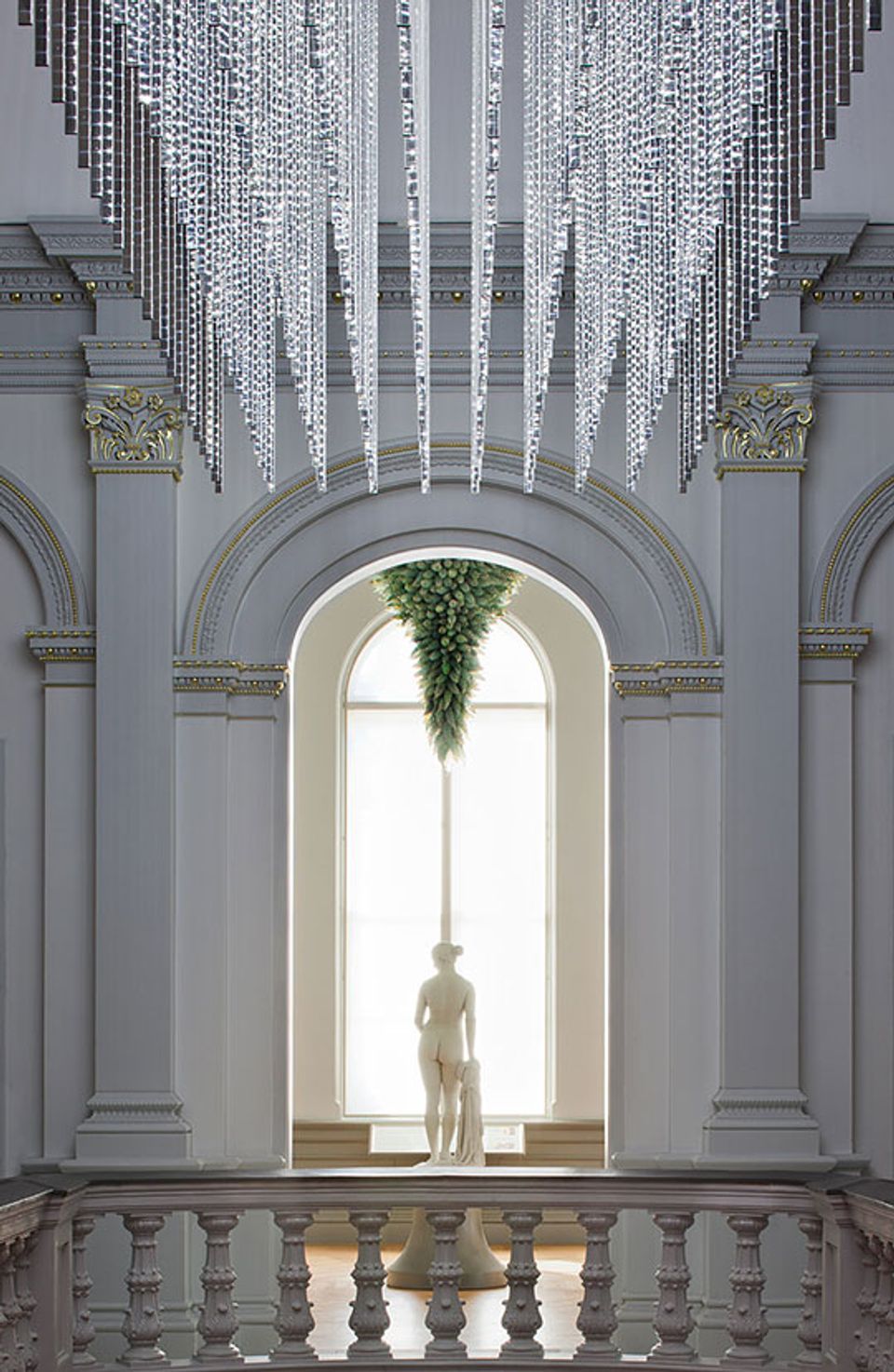
A blend of old and new: Leo Villareal's Volume (Renwick), Dale Chihuly's Seafoam and Amber-tipped Chandelier and Hiram Power's Greek Slave. Photo by Ron Blunt.

The reopening of the Renwick is cause for celebration: WONDER is setting attendance records and turning visitors into instant Instagrammers. Eye Level recently sat down with Renwick curators Nicholas Bell (The Fleur and Charles Bresler Curator-in-Charge) and Nora Atkinson (Lloyd Herman Curator of Craft) to talk about the museum's renovation, the intersection of craft and technology, and what the future holds.
Eye Level: The renovated Renwick strikes a balance between the historic and the state of the art. Can you address the conversation between the past, present, and future that's taking place in the building?
Nicholas Bell: What makes the Renwick very special is that so much of the history of the building is on view. You can see the fabric of Renwick and Corcoran's original vision to make this very auspicious space something of a landmark 156 years ago. Although that has been covered up during different generations of use, we have been able to uncover as much as possible so that what you are walking through is fairly close to the experience you would have had in the building even as far back as the 1870s in terms of its structure. The Corcoran "C"s are still above the door and those flourishes are part of the building. The plaster cornices have been carefully maintained. We are attempting to bring a level of craftsmanship to the building and the visitor experience such as hand gilding. However, that could describe the life of various buildings. What makes the Renwick unique is that we are treating this historic foundation very carefully, but at the same time using it to launch into an investigation of how our interaction with the material world is evolving in ways we can barely foresee and have been thrust upon us. It is often said that we are living through a new industrial revolution, with new technologies that will change the way we live and think about the world.
EL: Can you share an example from the museum?
Nicholas: Transitioning the entire building to LED lighting, for example, is one way to embrace that revolution. Taking a 19th-century sculpture, Hiram Powers' Greek Slave, and recreating it via a 3D printer is another way to tip our hat at that flood of creative technology. Together, our eye on the future and our careful protection of the past has created something of an unusual, and maybe even a thrilling place to visit.
EL: How do these ideas help to change our perceptions of "craft" vs. "art"?
Nora Atkinson: The craft vs. art debate has been around for decades and is showing no sign of ending, but that was not a real concern of ours. What we wanted to do here is forget about those rigid distinctions and look at craft more as a language of process and materiality that can teach us something about the world. As a craft museum that’s positioning itself for the future, it’s the perfect time for us to be exploring these questions because craft, maybe as opposed to art, is so frequently thought of as backward looking and nostalgic. Craft, to me, is not so much about romanticizing the past, but more about stopping the tide of always thinking the “new and next” is the best thing. It examines the positives and negatives of progress in light of where we’ve come from, and finds that balance between the two. What we have in the architecture, for example, when it comes into contact with Leo Villareal’s light sculpture Volume in WONDER, is a very gentle harmony between the beauty of hand-crafted work done with the tools of the time which probably couldn’t be recreated today, and what’s being done now with cutting edge technologies. Craft has a remarkable ability to comment on our history and future with that kind of real world experience.
EL: Can craft and technology play well together?
Nicholas: There are people interested in the way technology is changing their craft and they are not shy about investigating those techologies. We find ourselves defending this kind of use within what people called the craft field there is often this assumption that you should be reaching back into history, which is really just a nostalgic action. Craft does not mean that you are trying to stop progress. It means that you are passionately invested in that process. That is a passion that can cross any technology.
EL: What will the Renwick's post-WONDER life look like?
Nora: When we put the permanent collection back on view on the second floor one of the things we want to do is to get away from the medium-based or period-based view of how we display the objects and how we put objects together. The newly installed galleries in the permanent collection will still be a sensory overload: eighty pieces in 4 galleries. The galleries will transform from massive one-person installations to many small objects. The upcoming Renwick Invitational on the ground floor will still capture that sense of WONDER. Jennifer Trask, for example, works with gilt antique frames and bone to create vanitas type arrangements of floral compositions. We’ll be interested to see how people react to a return to craft in a way, a return to small objects, but hopefully seeing them in a different light.



















